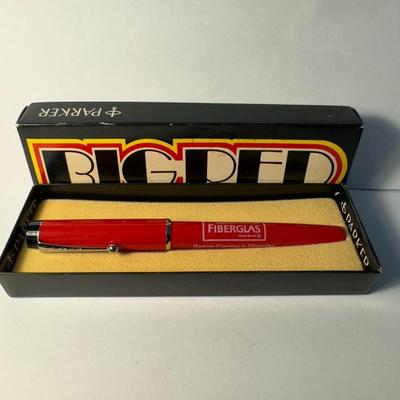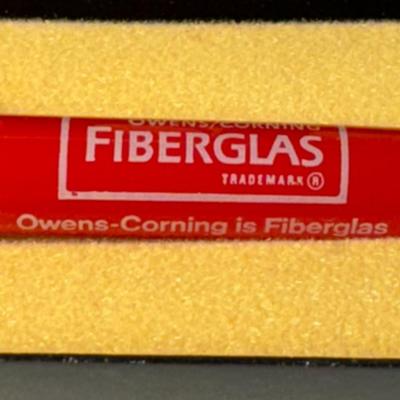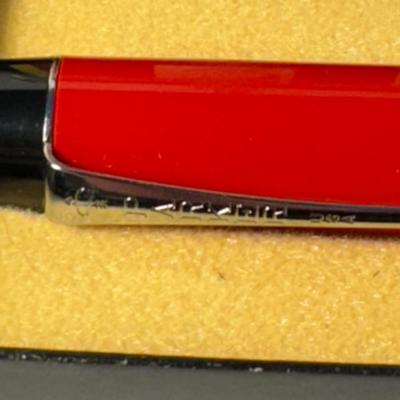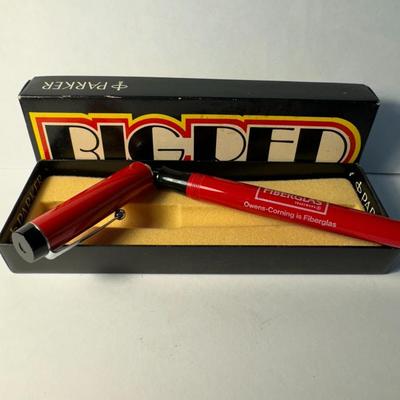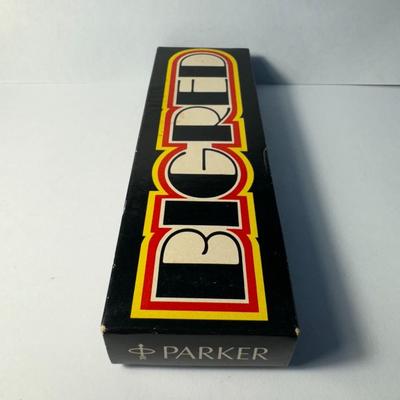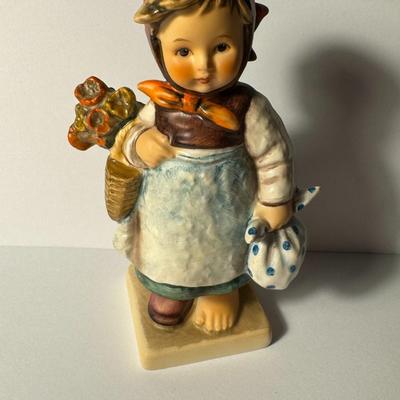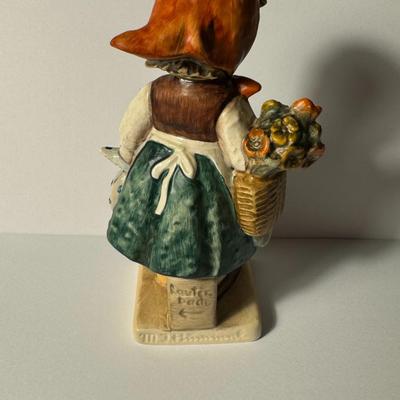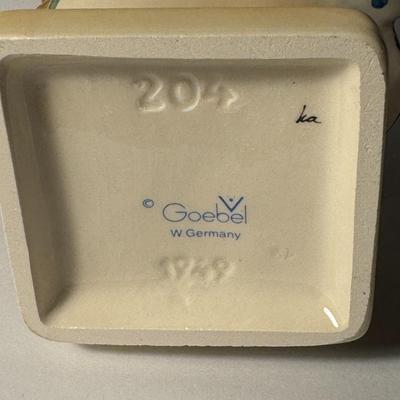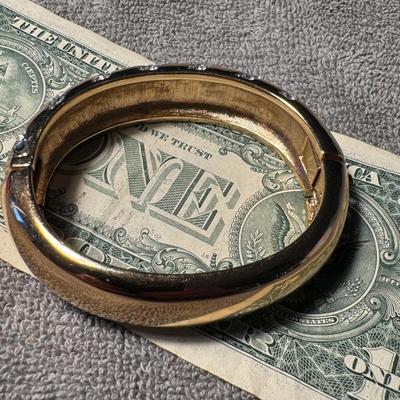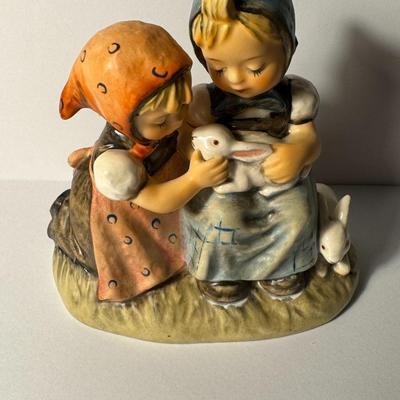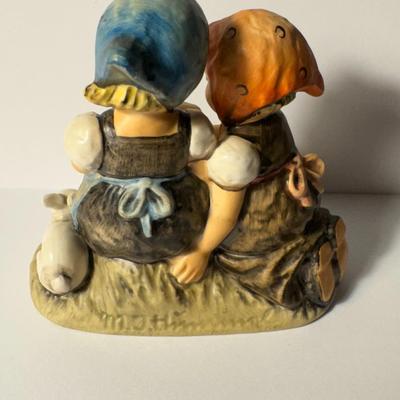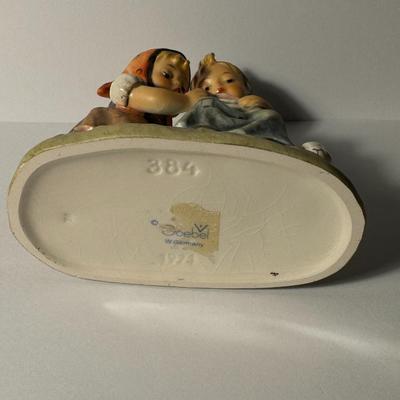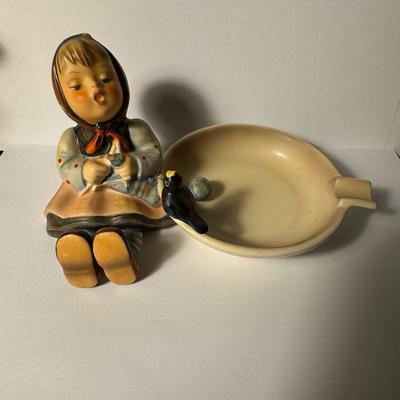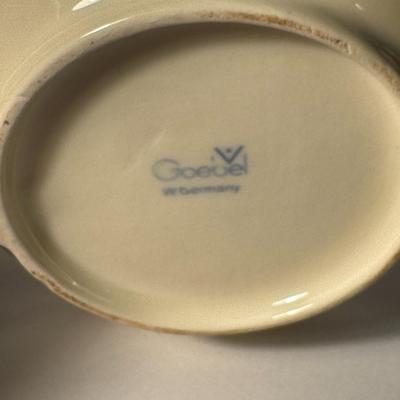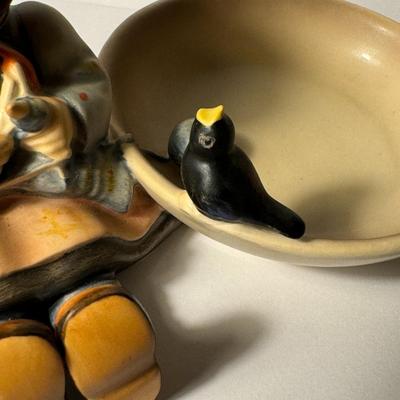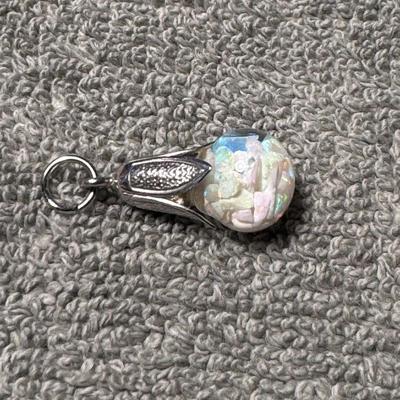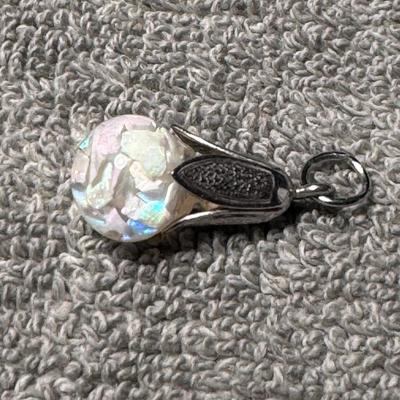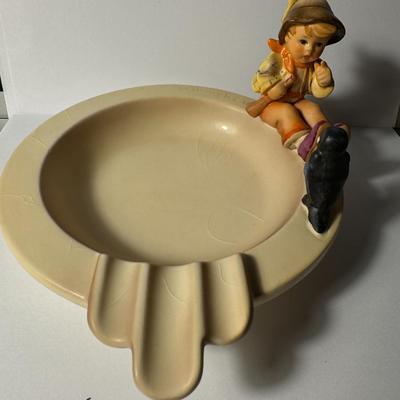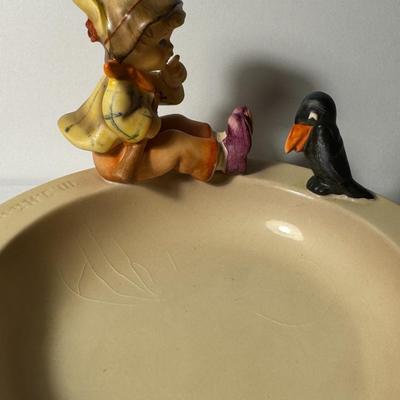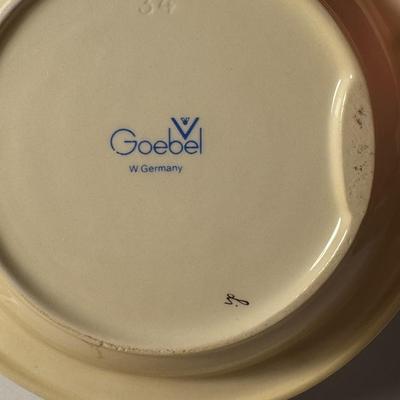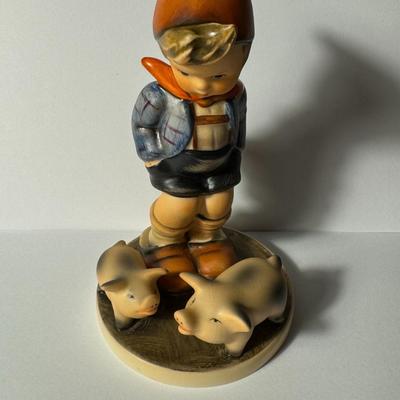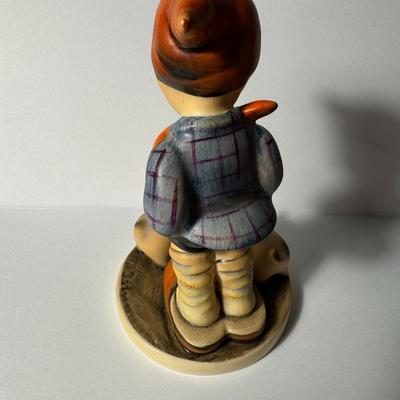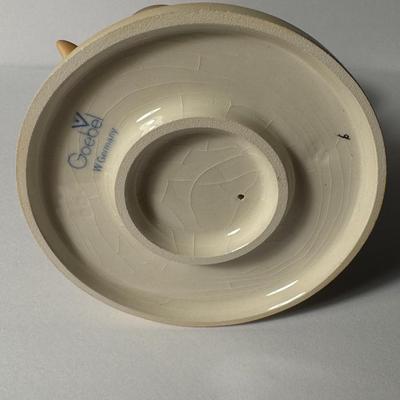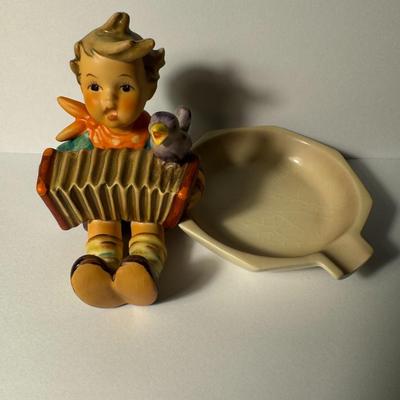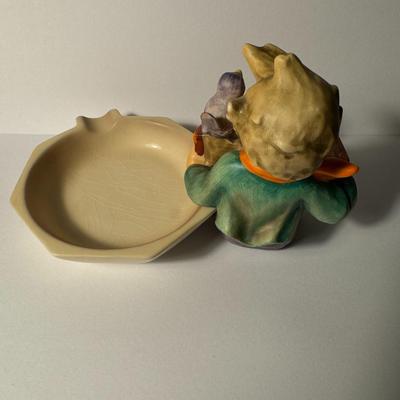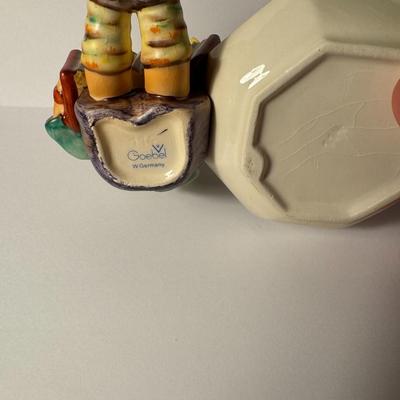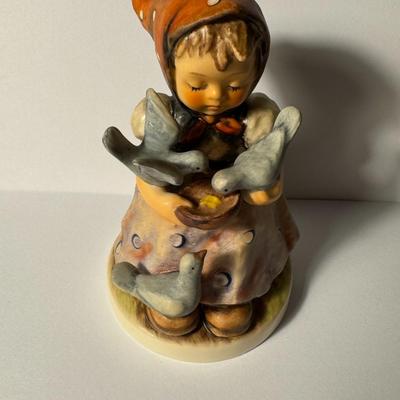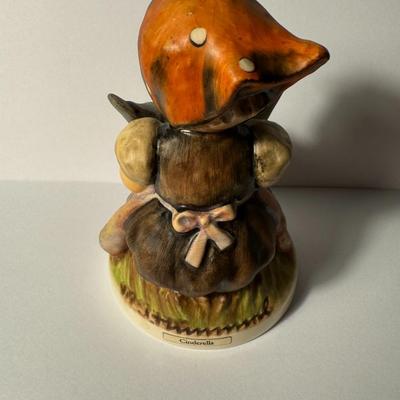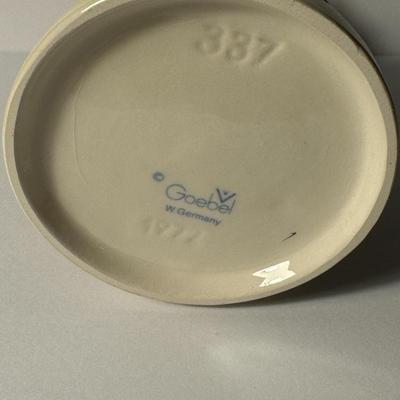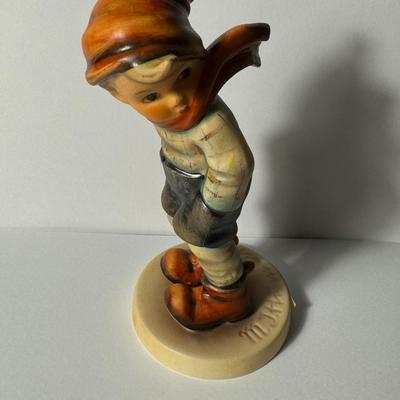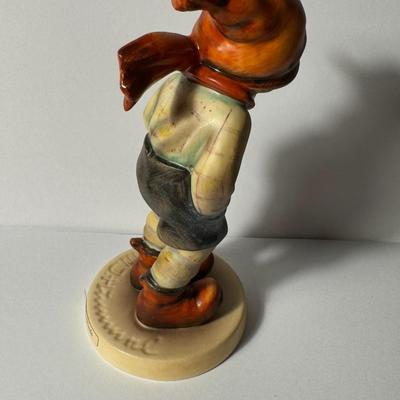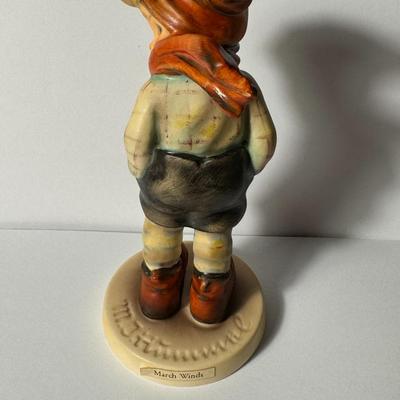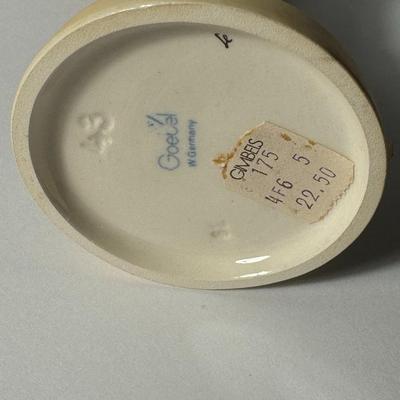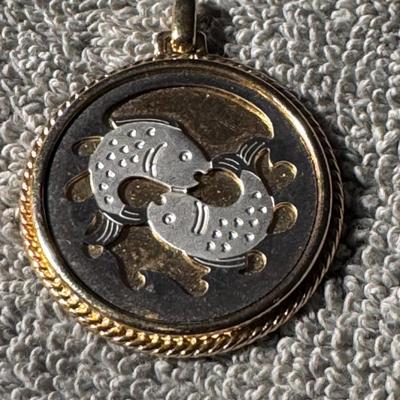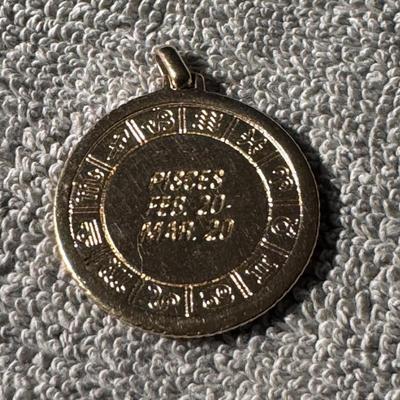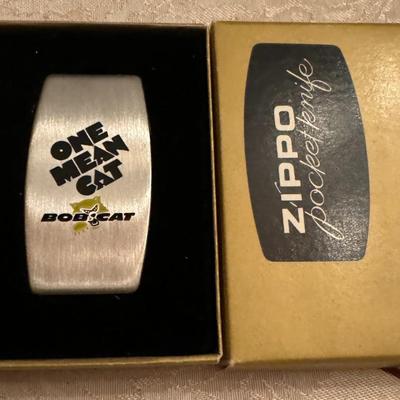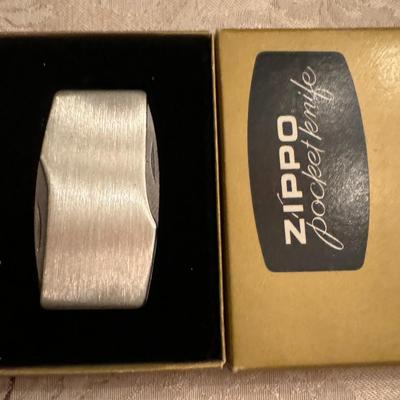-
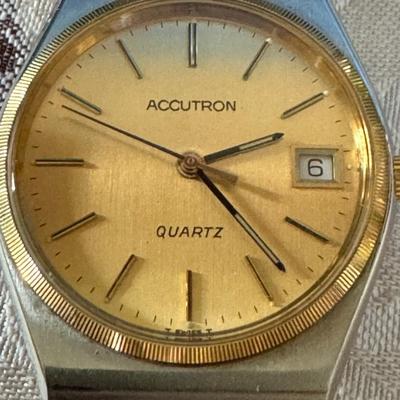
Bulova Accutron Quartz watch. Historical context of Bulova Accutron: Tuning Fork Era: Bulova introduced the revolutionary Accutron watch in 1960, utilizing a tuning fork instead of a balance wheel, resulting in significantly improved accuracy for its time, states Teddy Baldassarre. These watches were highly praised for their precision and were even used in NASA missions. The rise of Quartz: In the late 1970s, as quartz watch technology gained prominence, Accutron began transitioning to quartz movements to remain competitive. 806 / 1369 -
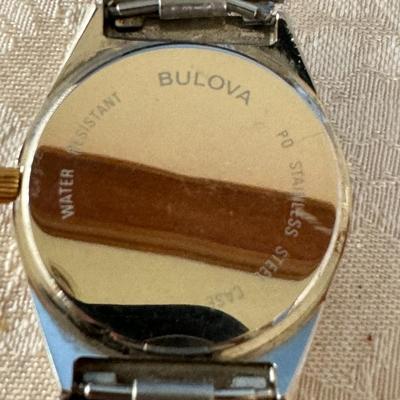
Bulova Accutron Quartz watch. Historical context of Bulova Accutron: Tuning Fork Era: Bulova introduced the revolutionary Accutron watch in 1960, utilizing a tuning fork instead of a balance wheel, resulting in significantly improved accuracy for its time, states Teddy Baldassarre. These watches were highly praised for their precision and were even used in NASA missions. The rise of Quartz: In the late 1970s, as quartz watch technology gained prominence, Accutron began transitioning to quartz movements to remain competitive. 807 / 1369 -
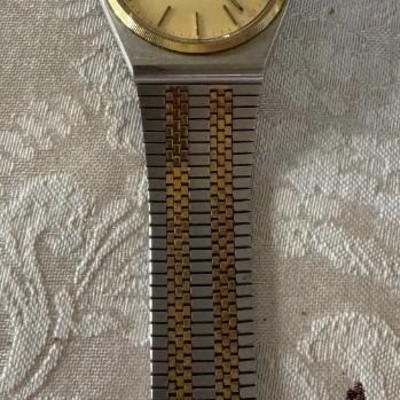
Bulova Accutron Quartz watch. Historical context of Bulova Accutron: Tuning Fork Era: Bulova introduced the revolutionary Accutron watch in 1960, utilizing a tuning fork instead of a balance wheel, resulting in significantly improved accuracy for its time, states Teddy Baldassarre. These watches were highly praised for their precision and were even used in NASA missions. The rise of Quartz: In the late 1970s, as quartz watch technology gained prominence, Accutron began transitioning to quartz movements to remain competitive. 808 / 1369 -
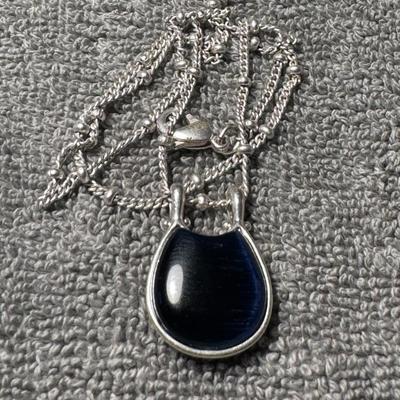
Lia Sophia necklace featuring a silver-colored chain and a striking navy blue oval-shaped resin pendant. Details about this type of necklace: Design: The necklace combines a classic silver-tone chain with a modern pendant, making it a versatile piece suitable for various occasions. Material: The pendant appears to be made of a navy blue resin or a similar material designed to resemble a stone or cat's eye. Brand: Lia Sophia was a direct sales jewelry company known for its fashionable and accessible designs. 814 / 1369 -
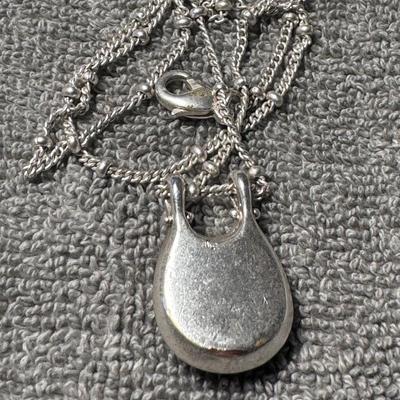
Lia Sophia necklace featuring a silver-colored chain and a striking navy blue oval-shaped resin pendant. Details about this type of necklace: Design: The necklace combines a classic silver-tone chain with a modern pendant, making it a versatile piece suitable for various occasions. Material: The pendant appears to be made of a navy blue resin or a similar material designed to resemble a stone or cat's eye. Brand: Lia Sophia was a direct sales jewelry company known for its fashionable and accessible designs. 815 / 1369 -
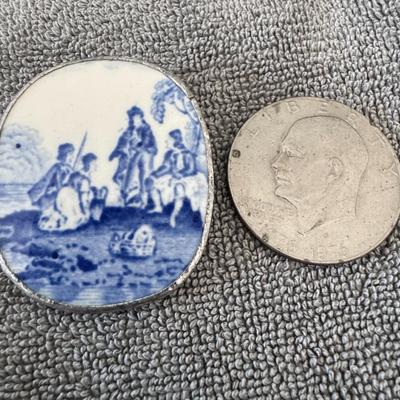
Royal Doulton brooch or pin, identifiable by its distinct backstamp on the reverse side of the ceramic piece. Item Identification: This is a Royal Doulton brooch or pin crafted from ceramic, likely bone china, given the common use of this material by the company for decorative items. The silver-colored fitting on the back indicates it was designed to be worn as a piece of jewelry. Backstamp and Age: The visible backstamp features the Royal Doulton lion and crown mark above the words "ROYAL DOULTON ENGLAND". This specific mark was primarily used during two periods: 1901-1922 and then again from 1927-circa 1936. This helps in dating the piece to one of these two ranges. Material and Craftsmanship: Royal Doulton is renowned for its high-quality porcelain and bone china, and this pin would have been meticulously crafted, potentially featuring hand-painted designs on the obverse side. 816 / 1369 -
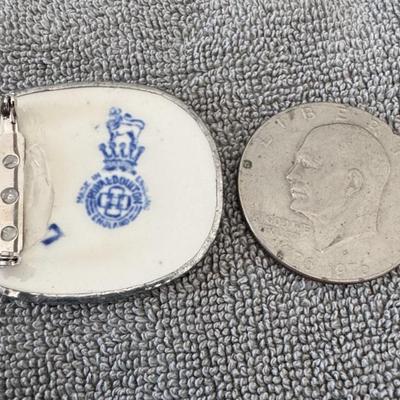
Royal Doulton brooch or pin, identifiable by its distinct backstamp on the reverse side of the ceramic piece. Item Identification: This is a Royal Doulton brooch or pin crafted from ceramic, likely bone china, given the common use of this material by the company for decorative items. The silver-colored fitting on the back indicates it was designed to be worn as a piece of jewelry. Backstamp and Age: The visible backstamp features the Royal Doulton lion and crown mark above the words "ROYAL DOULTON ENGLAND". This specific mark was primarily used during two periods: 1901-1922 and then again from 1927-circa 1936. This helps in dating the piece to one of these two ranges. Material and Craftsmanship: Royal Doulton is renowned for its high-quality porcelain and bone china, and this pin would have been meticulously crafted, potentially featuring hand-painted designs on the obverse side. 817 / 1369 -
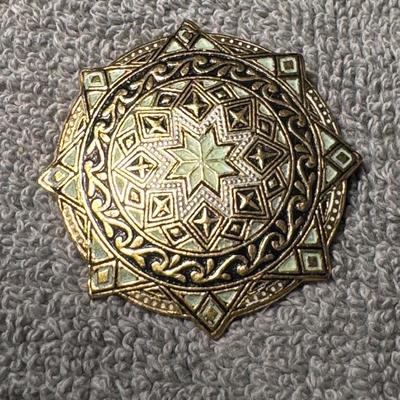
Damascene brooch or pin, likely originating from Toledo, Spain. Here's more information about this type of piece: Damascene Art: This is a traditional decorative art form where designs are inlaid in one metal (often gold or silver) into another (like steel or iron), then often blackened to create a striking contrast. Origin: Toledo, Spain, is particularly famous for its Damascene craftsmanship, especially in jewelry and decorative objects. Design: The piece features a prominent octagonal star design in a gold tone, which is a common motif in Damascene jewelry. The intricate details surrounding the star are characteristic of this art form. 818 / 1369 -
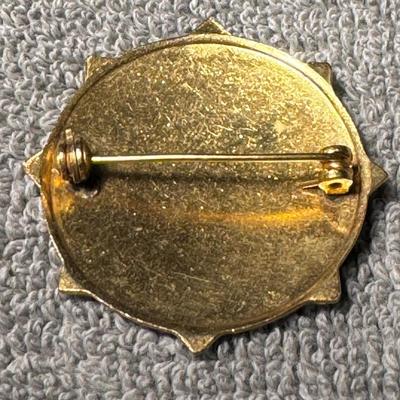
Damascene brooch or pin, likely originating from Toledo, Spain. Here's more information about this type of piece: Damascene Art: This is a traditional decorative art form where designs are inlaid in one metal (often gold or silver) into another (like steel or iron), then often blackened to create a striking contrast. Origin: Toledo, Spain, is particularly famous for its Damascene craftsmanship, especially in jewelry and decorative objects. Design: The piece features a prominent octagonal star design in a gold tone, which is a common motif in Damascene jewelry. The intricate details surrounding the star are characteristic of this art form. 819 / 1369 -
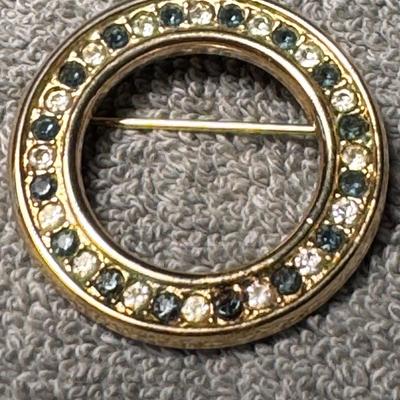
vintage gold tone rhinestone circle brooch. Here's a breakdown of its features and potential information: Design: It's a classic circular brooch, likely from the mid-20th century (e.g., 1950s-1960s), adorned with sparkling rhinestones set in a gold-tone metal. Materials: The brooch features a gold-colored base metal and clear and possibly blue-hued rhinestones arranged around the circumference. Purpose: Brooches like this were popular accessories for adding a touch of elegance and sparkle to clothing, often worn on lapels, dresses, or scarves. 823 / 1369 -
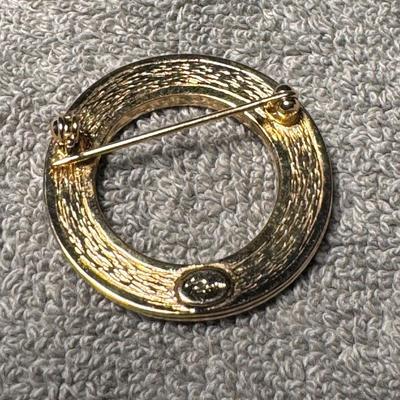
vintage gold tone rhinestone circle brooch. Here's a breakdown of its features and potential information: Design: It's a classic circular brooch, likely from the mid-20th century (e.g., 1950s-1960s), adorned with sparkling rhinestones set in a gold-tone metal. Materials: The brooch features a gold-colored base metal and clear and possibly blue-hued rhinestones arranged around the circumference. Purpose: Brooches like this were popular accessories for adding a touch of elegance and sparkle to clothing, often worn on lapels, dresses, or scarves. 824 / 1369 -
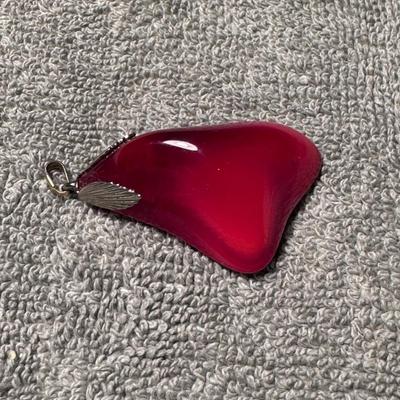
Purpose: These pieces are typically worn as decorative accessories on clothing, but some can also be designed as versatile pin/pendant combinations. Origin: While specific origins can vary, similar items have been identified as both antique and handmade by artists specializing in shell jewelry, such as those working with natural conch shells. 825 / 1369 -
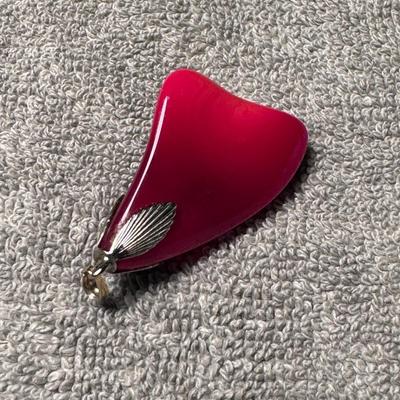
Purpose: These pieces are typically worn as decorative accessories on clothing, but some can also be designed as versatile pin/pendant combinations. Origin: While specific origins can vary, similar items have been identified as both antique and handmade by artists specializing in shell jewelry, such as those working with natural conch shells. 826 / 1369 -

HO Scale Pennsylvania Railroad EMD F7A Diesel Locomotive. Here's a breakdown of the model based on the image and related information: Road Name & Number: The locomotive is clearly labeled "PENNSYLVANIA" and bears the number "9508" [Image]. Locomotive Type: It's an EMD F7A unit, a popular diesel-electric locomotive type used by various railroads, including the Pennsylvania Railroad (PRR). Scale: Based on common model train scales for such detailed units, it is most likely an HO Scale model, although N scale versions also exist. 835 / 1369 -
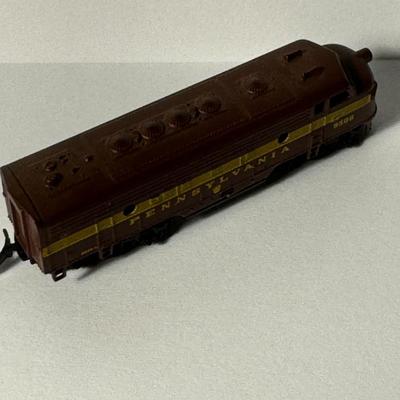
HO Scale Pennsylvania Railroad EMD F7A Diesel Locomotive. Here's a breakdown of the model based on the image and related information: Road Name & Number: The locomotive is clearly labeled "PENNSYLVANIA" and bears the number "9508" [Image]. Locomotive Type: It's an EMD F7A unit, a popular diesel-electric locomotive type used by various railroads, including the Pennsylvania Railroad (PRR). Scale: Based on common model train scales for such detailed units, it is most likely an HO Scale model, although N scale versions also exist. 836 / 1369 -

HO Scale Pennsylvania Railroad EMD F7A Diesel Locomotive. Here's a breakdown of the model based on the image and related information: Road Name & Number: The locomotive is clearly labeled "PENNSYLVANIA" and bears the number "9508" [Image]. Locomotive Type: It's an EMD F7A unit, a popular diesel-electric locomotive type used by various railroads, including the Pennsylvania Railroad (PRR). Scale: Based on common model train scales for such detailed units, it is most likely an HO Scale model, although N scale versions also exist. 837 / 1369 -
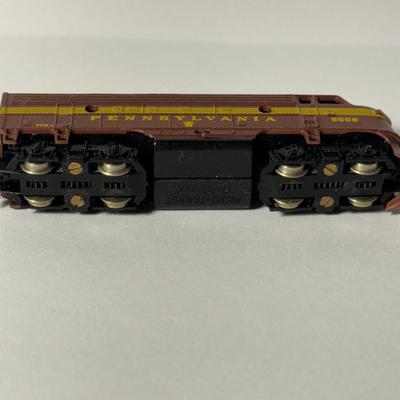
HO Scale Pennsylvania Railroad EMD F7A Diesel Locomotive. Here's a breakdown of the model based on the image and related information: Road Name & Number: The locomotive is clearly labeled "PENNSYLVANIA" and bears the number "9508" [Image]. Locomotive Type: It's an EMD F7A unit, a popular diesel-electric locomotive type used by various railroads, including the Pennsylvania Railroad (PRR). Scale: Based on common model train scales for such detailed units, it is most likely an HO Scale model, although N scale versions also exist. 838 / 1369 -
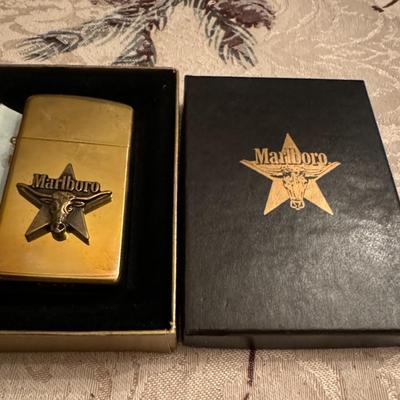
Marlboro Zippo lighter featuring a brass Longhorn Steer on a star emblem. This design appears to be from 1991. Several sources describe this specific design, with some indicating it's a Zippo lighter. It's a collectible item, especially for enthusiasts of Zippo lighters or Marlboro tobacco memorabilia. 842 / 1369 -
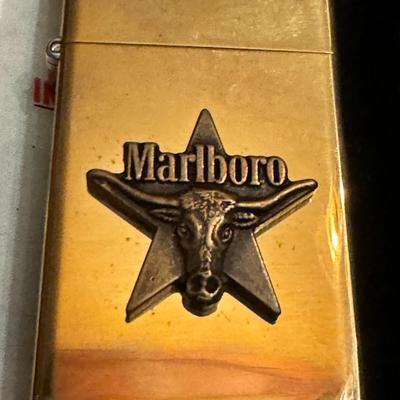
Marlboro Zippo lighter featuring a brass Longhorn Steer on a star emblem. This design appears to be from 1991. Several sources describe this specific design, with some indicating it's a Zippo lighter. It's a collectible item, especially for enthusiasts of Zippo lighters or Marlboro tobacco memorabilia. 843 / 1369 -
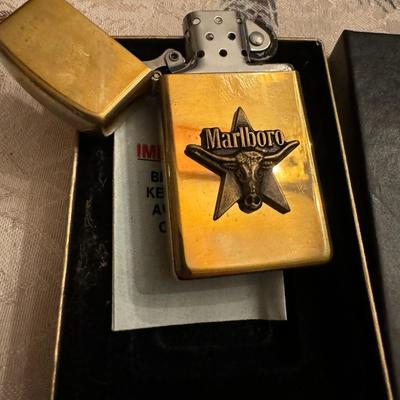
Marlboro Zippo lighter featuring a brass Longhorn Steer on a star emblem. This design appears to be from 1991. Several sources describe this specific design, with some indicating it's a Zippo lighter. It's a collectible item, especially for enthusiasts of Zippo lighters or Marlboro tobacco memorabilia. 844 / 1369 -
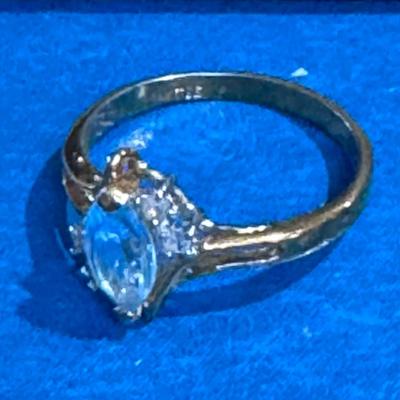
ring featuring a prominent aquamarine gemstone. The stone appears to be a light blue, which is characteristic of aquamarine, often associated with the serene colors of the ocean. About Aquamarine Rings: Symbolism: Aquamarine is known for symbolizing qualities such as clarity, peace, serenity, and courage, making it a meaningful choice for jewelry, especially engagement rings. Popularity: Aquamarine rings are a popular and stylish choice in modern jewelry, often favored for their tranquil blue tones and relative affordability compared to diamonds. Styles: Common ring designs featuring aquamarine include solitaire settings (highlighting the central stone), halo settings (surrounding the aquamarine with smaller diamonds), and vintage-inspired designs with intricate details. 848 / 1369 -
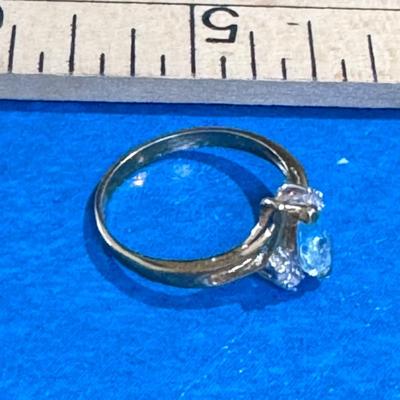
ring featuring a prominent aquamarine gemstone. The stone appears to be a light blue, which is characteristic of aquamarine, often associated with the serene colors of the ocean. About Aquamarine Rings: Symbolism: Aquamarine is known for symbolizing qualities such as clarity, peace, serenity, and courage, making it a meaningful choice for jewelry, especially engagement rings. Popularity: Aquamarine rings are a popular and stylish choice in modern jewelry, often favored for their tranquil blue tones and relative affordability compared to diamonds. Styles: Common ring designs featuring aquamarine include solitaire settings (highlighting the central stone), halo settings (surrounding the aquamarine with smaller diamonds), and vintage-inspired designs with intricate details. 849 / 1369 -
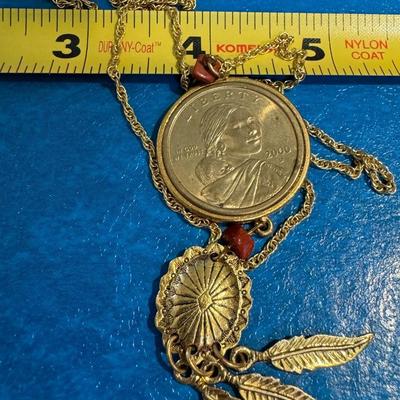
Coin necklace featuring a 2000 U.S. Sacagawea "Golden" Dollar coin as the central pendant. Here's a breakdown of the item: Coin: The main element is an authentic 2000 U.S. Sacagawea Dollar coin, known for its distinctive golden color and depiction of Sacagawea and her infant son, Jean Baptiste, on the obverse. Pendant Style: The coin is incorporated into a pendant design that also includes a decorative medallion with a sunburst-like pattern and three feather-shaped charms dangling below it. Chain and Embellishments: The pendant is suspended from a goldtone chain, and the design also incorporates small, reddish-brown beads, possibly carnelian or similar stones, above the main coin pendant. Origin/Style: This type of jewelry often draws inspiration from Native American or Southwestern design aesthetics, particularly with the inclusion of feather and coin elements. 853 / 1369 -
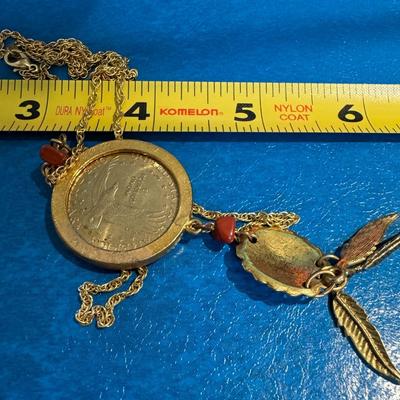
Coin necklace featuring a 2000 U.S. Sacagawea "Golden" Dollar coin as the central pendant. Here's a breakdown of the item: Coin: The main element is an authentic 2000 U.S. Sacagawea Dollar coin, known for its distinctive golden color and depiction of Sacagawea and her infant son, Jean Baptiste, on the obverse. Pendant Style: The coin is incorporated into a pendant design that also includes a decorative medallion with a sunburst-like pattern and three feather-shaped charms dangling below it. Chain and Embellishments: The pendant is suspended from a goldtone chain, and the design also incorporates small, reddish-brown beads, possibly carnelian or similar stones, above the main coin pendant. Origin/Style: This type of jewelry often draws inspiration from Native American or Southwestern design aesthetics, particularly with the inclusion of feather and coin elements. 854 / 1369 -
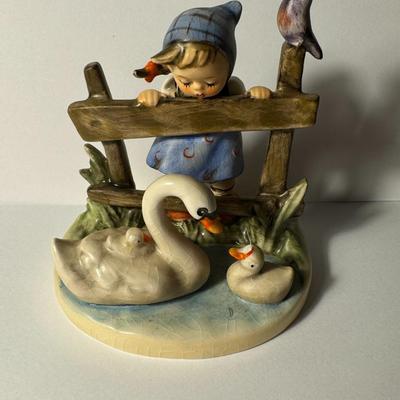
Figurine shows no chips, cracks or repairs. However, glaze does have some crazing The image shows a Hummel figurine titled "Feathered Friends". It is identified as Hummel number 344. This particular figurine features a young girl peering over a fence to observe a mother swan and her cygnets, along with a small bird perched on the fence. The figurine was made by Goebel in Germany, using porcelain and ceramic materials, and is hand-painted. This "Feathered Friends" Hummel #344 was created by artist M.I. Hummel. It belongs to the broader Hummel collection and falls under the decorative sculpture and figurine category. The figurine measures approximately 4 1/2 inches tall and 4 inches wide. Depending on the specific version and condition, this figurine can have a trademark number (TMK) on the bottom, indicating its production era. 855 / 1369 -
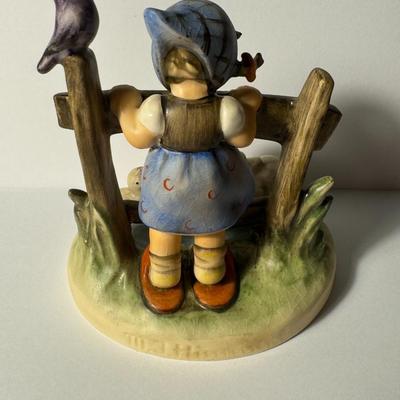
Figurine shows no chips, cracks or repairs. However, glaze does have some crazing The image shows a Hummel figurine titled "Feathered Friends". It is identified as Hummel number 344. This particular figurine features a young girl peering over a fence to observe a mother swan and her cygnets, along with a small bird perched on the fence. The figurine was made by Goebel in Germany, using porcelain and ceramic materials, and is hand-painted. This "Feathered Friends" Hummel #344 was created by artist M.I. Hummel. It belongs to the broader Hummel collection and falls under the decorative sculpture and figurine category. The figurine measures approximately 4 1/2 inches tall and 4 inches wide. Depending on the specific version and condition, this figurine can have a trademark number (TMK) on the bottom, indicating its production era. 856 / 1369 -
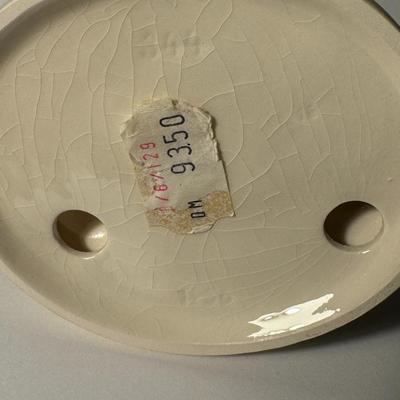
Figurine shows no chips, cracks or repairs. However, glaze does have some crazing The image shows a Hummel figurine titled "Feathered Friends". It is identified as Hummel number 344. This particular figurine features a young girl peering over a fence to observe a mother swan and her cygnets, along with a small bird perched on the fence. The figurine was made by Goebel in Germany, using porcelain and ceramic materials, and is hand-painted. This "Feathered Friends" Hummel #344 was created by artist M.I. Hummel. It belongs to the broader Hummel collection and falls under the decorative sculpture and figurine category. The figurine measures approximately 4 1/2 inches tall and 4 inches wide. Depending on the specific version and condition, this figurine can have a trademark number (TMK) on the bottom, indicating its production era. 857 / 1369 -
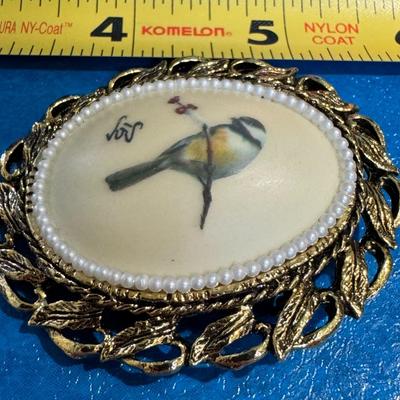
vintage enamel and pearl bird brooch. This type of brooch enamel plaque with a painted or enameled bird design, often surrounded by a border of faux pearls, as seen in your image. Here's more information about this style of brooch: Materials: These brooches commonly utilize materials such as gold-tone base metal or sterling silver, often combined with enamel work and faux pearls. Some examples, like those by the Norwegian maker Hjortdahl, are crafted from sterling silver with intricate enamel details, showcasing Scandinavian craftsmanship. Design: The central design often depicts a bird on a branch, sometimes with floral elements, or in other natural settings. The enamel work can be colorful, mimicking watercolor paints, and the pearls add a touch of elegance and vintage charm. Origin & Style: While the specific origin of your brooch is not marked, similar designs are often associated with vintage and antique jewelry, including Scandinavian pieces, particularly those from Norway by makers like O.F. Hjortdahl. Collectibility: Vintage enamel bird brooches, especially those in good condition and by known makers, are sought after by collectors of antique and vintage jewelry 858 / 1369 -
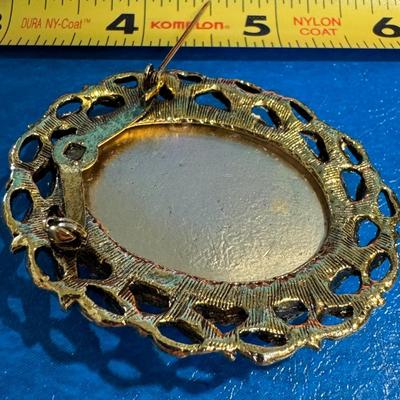
vintage enamel and pearl bird brooch. This type of brooch enamel plaque with a painted or enameled bird design, often surrounded by a border of faux pearls, as seen in your image. Here's more information about this style of brooch: Materials: These brooches commonly utilize materials such as gold-tone base metal or sterling silver, often combined with enamel work and faux pearls. Some examples, like those by the Norwegian maker Hjortdahl, are crafted from sterling silver with intricate enamel details, showcasing Scandinavian craftsmanship. Design: The central design often depicts a bird on a branch, sometimes with floral elements, or in other natural settings. The enamel work can be colorful, mimicking watercolor paints, and the pearls add a touch of elegance and vintage charm. Origin & Style: While the specific origin of your brooch is not marked, similar designs are often associated with vintage and antique jewelry, including Scandinavian pieces, particularly those from Norway by makers like O.F. Hjortdahl. Collectibility: Vintage enamel bird brooches, especially those in good condition and by known makers, are sought after by collectors of antique and vintage jewelry 859 / 1369 -
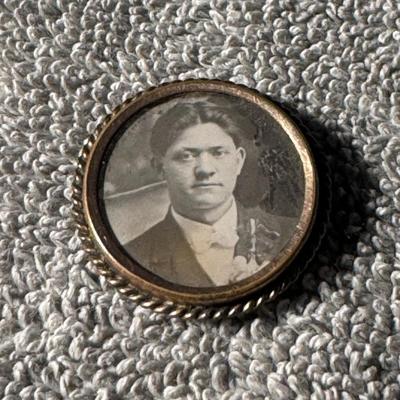
Antique Victorian Photo Brooch or Mourning Brooch. These historical jewelry pieces were popular during the Victorian era (1837-1901), especially after Queen Victoria's extended mourning for Prince Albert, which set a trend for incorporating memorial items into daily wear. Key characteristics and significance of such a brooch: Commemorative Purpose: It served as a personal token of remembrance for a deceased loved one, worn close to the heart to symbolize enduring affection and grief. Photo Inset: As seen in your image, these brooches often featured a photograph of the departed, though some also contained locks of hair, miniature portraits, or symbolic motifs under glass. Materials and Design: Typically, they were made with somber materials like black enamel, jet, or onyx, reflecting the mourning period's aesthetics. However, gold or other metals, often with intricate designs like the rope-twist border visible in your image, were also used to frame the memorial element. Historical Context: Mourning jewelry reflects the prevalent social customs and attitudes towards death and loss during the 19th century, a time when death was a more common and publicly acknowledged part of life 860 / 1369 -
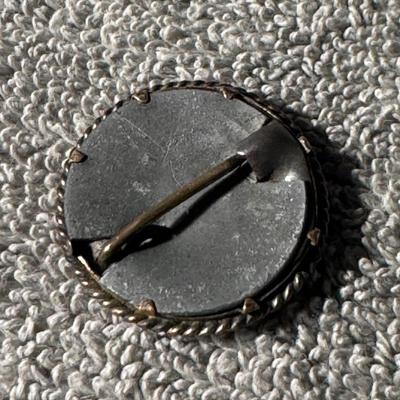
Antique Victorian Photo Brooch or Mourning Brooch. These historical jewelry pieces were popular during the Victorian era (1837-1901), especially after Queen Victoria's extended mourning for Prince Albert, which set a trend for incorporating memorial items into daily wear. Key characteristics and significance of such a brooch: Commemorative Purpose: It served as a personal token of remembrance for a deceased loved one, worn close to the heart to symbolize enduring affection and grief. Photo Inset: As seen in your image, these brooches often featured a photograph of the departed, though some also contained locks of hair, miniature portraits, or symbolic motifs under glass. Materials and Design: Typically, they were made with somber materials like black enamel, jet, or onyx, reflecting the mourning period's aesthetics. However, gold or other metals, often with intricate designs like the rope-twist border visible in your image, were also used to frame the memorial element. Historical Context: Mourning jewelry reflects the prevalent social customs and attitudes towards death and loss during the 19th century, a time when death was a more common and publicly acknowledged part of life 861 / 1369 -
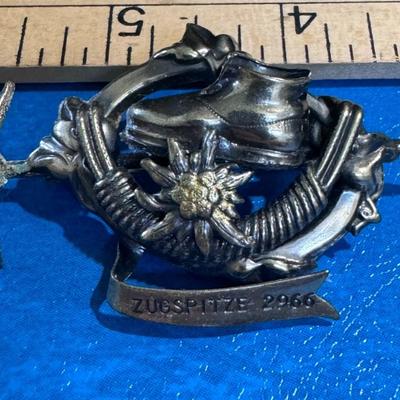
vintage German souvenir pin related to the Zugspitze mountain, which is Germany's highest peak. The pin features mountaineering elements such as a climbing boot, a pickaxe, and rope, along with an Edelweiss flower and a banner bearing the inscription "ZUGSPITZE 2966," referring to the mountain's elevation in meters. Here's more information about the pin: Origin and Purpose: This type of pin is a collectible souvenir from the Zugspitze mountain region in Germany, likely purchased by climbers, hikers, or tourists visiting the area. Design Elements: The pin incorporates classic alpine and mountaineering symbolism, including the iconic Edelweiss flower, a common emblem of the Alps and Bavaria. 868 / 1369 -
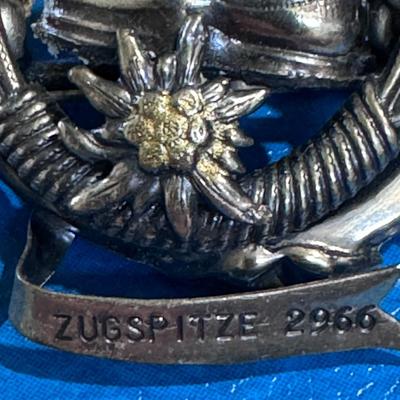
vintage German souvenir pin related to the Zugspitze mountain, which is Germany's highest peak. The pin features mountaineering elements such as a climbing boot, a pickaxe, and rope, along with an Edelweiss flower and a banner bearing the inscription "ZUGSPITZE 2966," referring to the mountain's elevation in meters. Here's more information about the pin: Origin and Purpose: This type of pin is a collectible souvenir from the Zugspitze mountain region in Germany, likely purchased by climbers, hikers, or tourists visiting the area. Design Elements: The pin incorporates classic alpine and mountaineering symbolism, including the iconic Edelweiss flower, a common emblem of the Alps and Bavaria. 869 / 1369 -
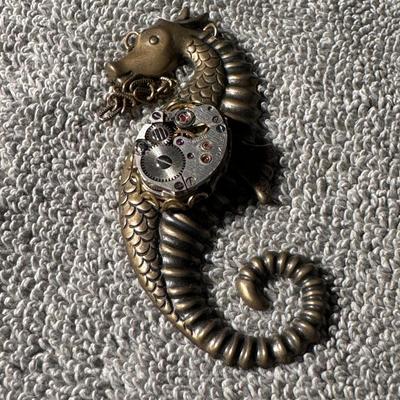
Steampunk Sea Dragon or Seahorse pendant a distinctive piece of jewelry that blends Victorian-era aesthetics with industrial and mechanical elements. Here's a breakdown of its features and context: Design: The pendant features a creature resembling a seahorse or a stylized sea dragon, crafted in a metallic tone, often bronze or antique silver, reflecting the industrial aspect of steampunk. Steampunk Elements: A key characteristic of this piece, and steampunk jewelry in general, is the incorporation of visible mechanical components, notably an exposed watch movement or gears, which are central to the steampunk aesthetic 870 / 1369 -
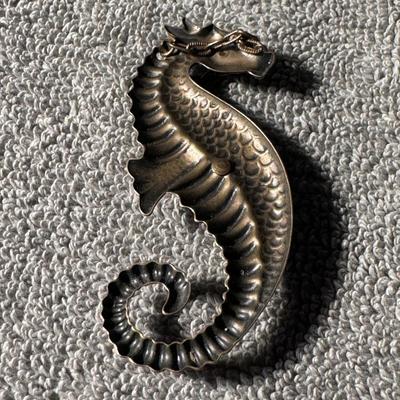
Steampunk Sea Dragon or Seahorse pendant a distinctive piece of jewelry that blends Victorian-era aesthetics with industrial and mechanical elements. Here's a breakdown of its features and context: Design: The pendant features a creature resembling a seahorse or a stylized sea dragon, crafted in a metallic tone, often bronze or antique silver, reflecting the industrial aspect of steampunk. Steampunk Elements: A key characteristic of this piece, and steampunk jewelry in general, is the incorporation of visible mechanical components, notably an exposed watch movement or gears, which are central to the steampunk aesthetic 871 / 1369 -
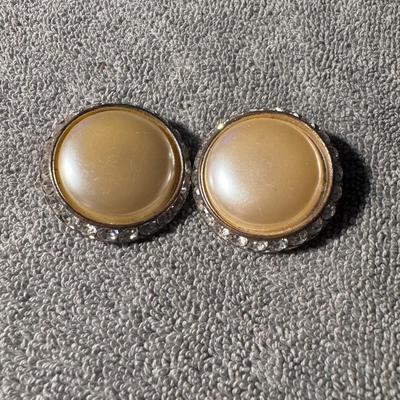
vintage clip-on earrings, likely from the mid-20th century, identifiable as Lisner Signed Clip On Earrings. Here's more information about these earrings: Brand and Signature: The earrings are signed by "Lisner," a well-known costume jewelry company that produced jewelry from the 1930s through the late 1980s, gaining popularity for its quality craftsmanship and affordability. Style: These particular earrings feature a central faux pearl or thermoset material in a beige/tan color, encircled by a trim of clear rhinestones, giving them a classic and elegant "button" style. Mechanism: They are designed as clip-on earrings, meaning they do not require pierced ears and attach via a clip mechanism on the back. 872 / 1369 -
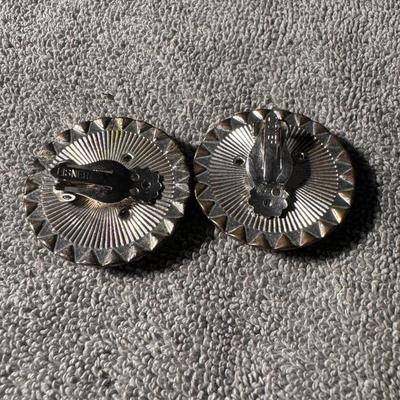
vintage clip-on earrings, likely from the mid-20th century, identifiable as Lisner Signed Clip On Earrings. Here's more information about these earrings: Brand and Signature: The earrings are signed by "Lisner," a well-known costume jewelry company that produced jewelry from the 1930s through the late 1980s, gaining popularity for its quality craftsmanship and affordability. Style: These particular earrings feature a central faux pearl or thermoset material in a beige/tan color, encircled by a trim of clear rhinestones, giving them a classic and elegant "button" style. Mechanism: They are designed as clip-on earrings, meaning they do not require pierced ears and attach via a clip mechanism on the back. 873 / 1369 -
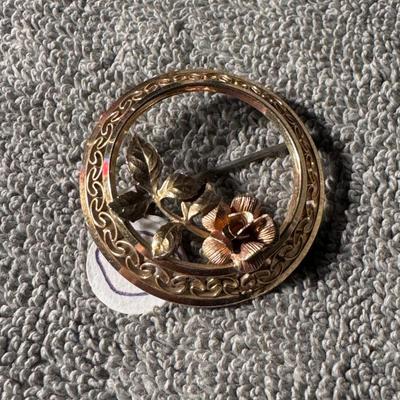
Vintage Krementz 12K Gold Filled Rose Circle Brooch Pin, likely dating from the mid-20th century. Here's more about this type of piece: Brand and Material: It's a signed Krementz piece, known for its high-quality gold-filled jewelry, particularly the "12K Gold Filled" which means a thick layer of 12k gold is mechanically bonded to a base metal. Design: The brooch features a circular, often filigree or textured, frame with a raised rose and possibly leaf motif, often incorporating two-tone gold effects (yellow and rose gold). Historical Context: Krementz & Co. was established in 1866 and expanded into women's costume jewelry in the 1930s, becoming known for their durable and aesthetically pleasing gold-filled pieces, which offered the look of fine jewelry at a more accessible price point. 874 / 1369 -
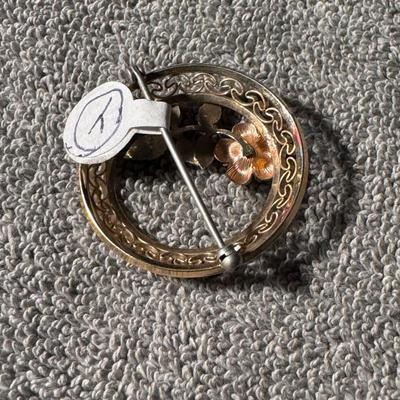
Vintage Krementz 12K Gold Filled Rose Circle Brooch Pin, likely dating from the mid-20th century. Here's more about this type of piece: Brand and Material: It's a signed Krementz piece, known for its high-quality gold-filled jewelry, particularly the "12K Gold Filled" which means a thick layer of 12k gold is mechanically bonded to a base metal. Design: The brooch features a circular, often filigree or textured, frame with a raised rose and possibly leaf motif, often incorporating two-tone gold effects (yellow and rose gold). Historical Context: Krementz & Co. was established in 1866 and expanded into women's costume jewelry in the 1930s, becoming known for their durable and aesthetically pleasing gold-filled pieces, which offered the look of fine jewelry at a more accessible price point. 875 / 1369 -
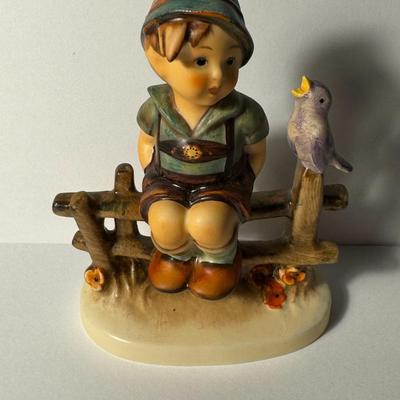
Hummel figurine titled "Wayside Harmony". It is model number 111. The figurine depicts a young boy dressed in traditional lederhosen and a hat, sitting on a fence while being entertained by a chirping songbird perched on one of the posts. This particular figurine was introduced in 1938 and is a popular collectible. The figurine is marked with "MI Hummel" dating it between 1964-1972. Wayside Harmony was previously known as "Just Sittin'-Boy". The companion figurine to Wayside Harmony is "Just Resting" 878 / 1369 -
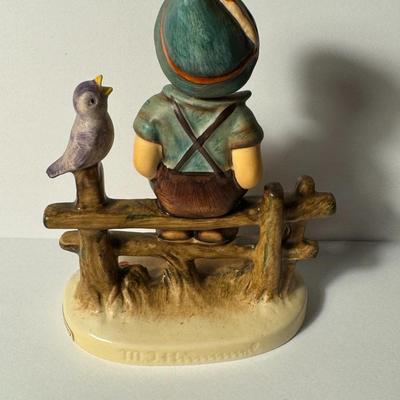
Hummel figurine titled "Wayside Harmony". It is model number 111. The figurine depicts a young boy dressed in traditional lederhosen and a hat, sitting on a fence while being entertained by a chirping songbird perched on one of the posts. This particular figurine was introduced in 1938 and is a popular collectible. The figurine is marked with "MI Hummel" dating it between 1964-1972. Wayside Harmony was previously known as "Just Sittin'-Boy". The companion figurine to Wayside Harmony is "Just Resting" 879 / 1369 -
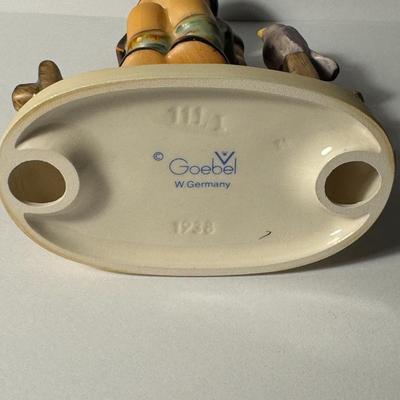
Hummel figurine titled "Wayside Harmony". It is model number 111. The figurine depicts a young boy dressed in traditional lederhosen and a hat, sitting on a fence while being entertained by a chirping songbird perched on one of the posts. This particular figurine was introduced in 1938 and is a popular collectible. The figurine is marked with "MI Hummel" dating it between 1964-1972. Wayside Harmony was previously known as "Just Sittin'-Boy". The companion figurine to Wayside Harmony is "Just Resting" 880 / 1369 -
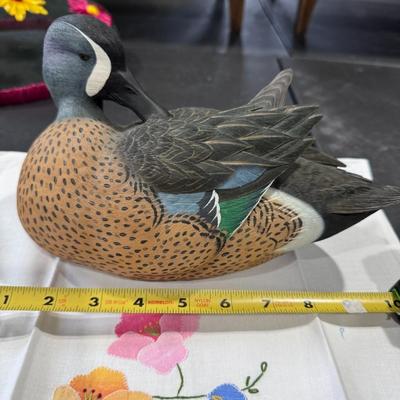
This Blue Wing Teal is made of resin and designed from the original wood carving by the World Champion waterfowl carver Jett Brunet of Louisiana; it is painted in flawless detail representing the real life bird. The decoy has the Special Edition medallion inlaid in the felt covered bottom. 881 / 1369 -
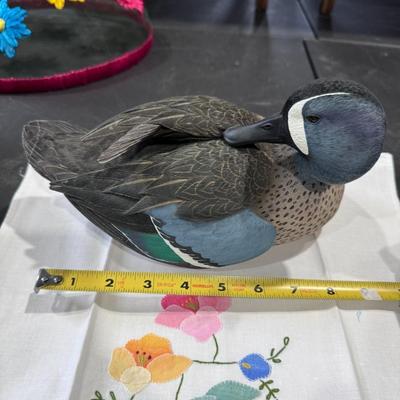
This Blue Wing Teal is made of resin and designed from the original wood carving by the World Champion waterfowl carver Jett Brunet of Louisiana; it is painted in flawless detail representing the real life bird. The decoy has the Special Edition medallion inlaid in the felt covered bottom. 882 / 1369 -
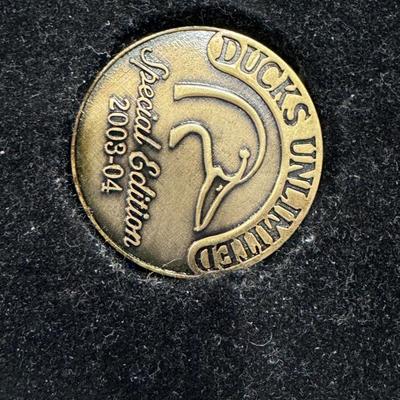
This Blue Wing Teal is made of resin and designed from the original wood carving by the World Champion waterfowl carver Jett Brunet of Louisiana; it is painted in flawless detail representing the real life bird. The decoy has the Special Edition medallion inlaid in the felt covered bottom. 883 / 1369 -
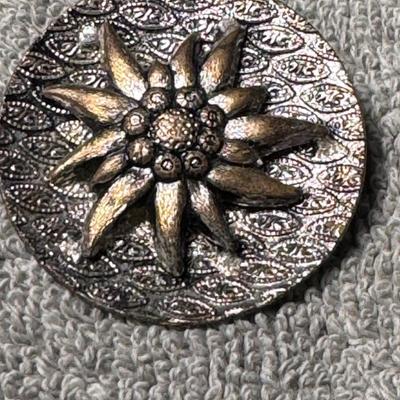
Antique GESCH Raised Silver Edelweiss Flower Brooch, likely made of brass with a silver finish, dating from the Victorian or Edwardian era. Here's more about this type of brooch: Design and Features: It features a raised Edelweiss flower design set against a textured or cross-hatched background. The term "GESCH" refers to "Gesetzlich Geschützt," a German term meaning "legally protected" or "trademarked," indicating its origin and design protection. Material and Condition: While primarily brass, these buttons often have a silvered finish that may show wear due to their age. 884 / 1369 -
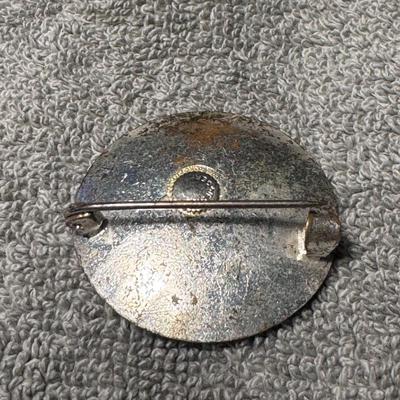
Antique GESCH Raised Silver Edelweiss Flower Brooch, likely made of brass with a silver finish, dating from the Victorian or Edwardian era. Here's more about this type of brooch: Design and Features: It features a raised Edelweiss flower design set against a textured or cross-hatched background. The term "GESCH" refers to "Gesetzlich Geschützt," a German term meaning "legally protected" or "trademarked," indicating its origin and design protection. Material and Condition: While primarily brass, these buttons often have a silvered finish that may show wear due to their age. 885 / 1369 -
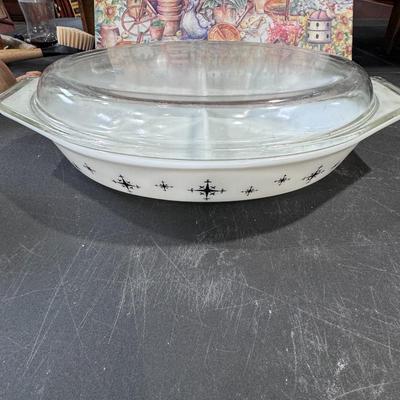
Pyrex Compass (also known as Black Star or Atomic Compass) Pattern Divided Casserole Dish with Lid. Key details about this item: Pattern Name: Pyrex Compass, also referred to as Black Star or Atomic Compass pattern, characterized by black stylized compasses or starbursts on a white milk glass base. Type: This is a vintage Pyrex divided oval casserole dish or snack server, designed for serving multiple items in separate compartments. Capacity: Commonly found in a 1.5-quart capacity (equivalent to 1 1/2 quarts). Era: It was manufactured around 1959, falling into the Mid-Century Modern period of Pyrex production. 886 / 1369 -
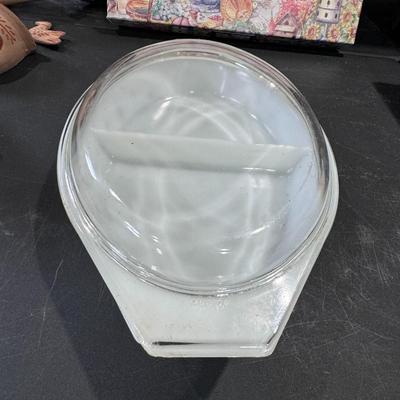
Pyrex Compass (also known as Black Star or Atomic Compass) Pattern Divided Casserole Dish with Lid. Key details about this item: Pattern Name: Pyrex Compass, also referred to as Black Star or Atomic Compass pattern, characterized by black stylized compasses or starbursts on a white milk glass base. Type: This is a vintage Pyrex divided oval casserole dish or snack server, designed for serving multiple items in separate compartments. Capacity: Commonly found in a 1.5-quart capacity (equivalent to 1 1/2 quarts). Era: It was manufactured around 1959, falling into the Mid-Century Modern period of Pyrex production. 887 / 1369 -
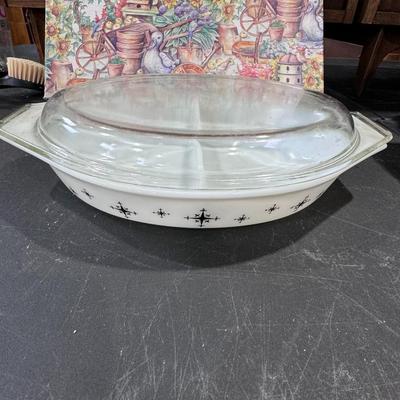
Pyrex Compass (also known as Black Star or Atomic Compass) Pattern Divided Casserole Dish with Lid. Key details about this item: Pattern Name: Pyrex Compass, also referred to as Black Star or Atomic Compass pattern, characterized by black stylized compasses or starbursts on a white milk glass base. Type: This is a vintage Pyrex divided oval casserole dish or snack server, designed for serving multiple items in separate compartments. Capacity: Commonly found in a 1.5-quart capacity (equivalent to 1 1/2 quarts). Era: It was manufactured around 1959, falling into the Mid-Century Modern period of Pyrex production. 888 / 1369 -
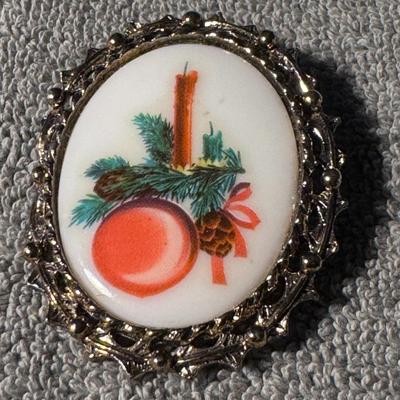
vintage oval Christmas holiday brooch or pin, likely from the mid-20th century. Here's a closer look at its features: Design: The brooch features a central oval motif with a hand-painted or decal design of a burning candle surrounded by festive elements like pine branches, pinecones, and a red ornament or berry. Material: The central oval is likely made of porcelain or milk glass with an enamel or painted design, set within an ornate gold-toned metal frame. Theme: The imagery clearly indicates a Christmas or winter holiday theme, making it a seasonal piece of costume jewelry. 889 / 1369 -
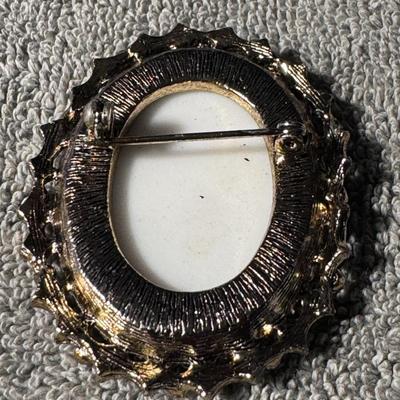
vintage oval Christmas holiday brooch or pin, likely from the mid-20th century. Here's a closer look at its features: Design: The brooch features a central oval motif with a hand-painted or decal design of a burning candle surrounded by festive elements like pine branches, pinecones, and a red ornament or berry. Material: The central oval is likely made of porcelain or milk glass with an enamel or painted design, set within an ornate gold-toned metal frame. Theme: The imagery clearly indicates a Christmas or winter holiday theme, making it a seasonal piece of costume jewelry. 890 / 1369 -
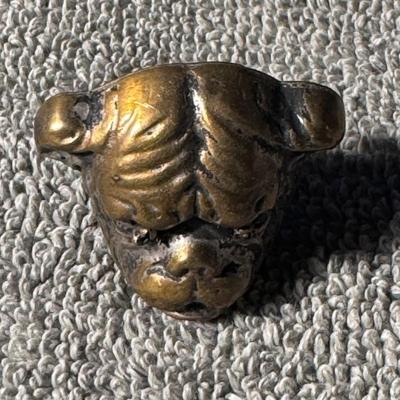
vintage or antique solid brass bulldog figurine head brooch Here's more information about this type of item: Material and Appearance: It is made of solid brass, often exhibiting a aged patina, giving it an antique look. The figurine depicts a bulldog's head in high relief, capturing its characteristic features like wrinkles and jowls. 891 / 1369 -
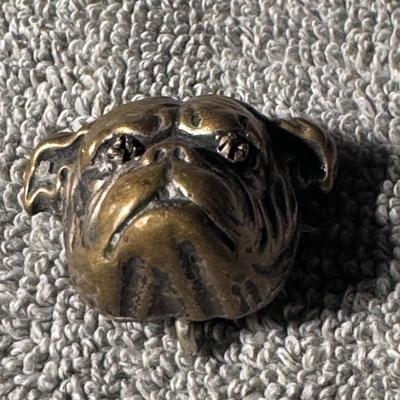
vintage or antique solid brass bulldog figurine head brooch Here's more information about this type of item: Material and Appearance: It is made of solid brass, often exhibiting a aged patina, giving it an antique look. The figurine depicts a bulldog's head in high relief, capturing its characteristic features like wrinkles and jowls. 892 / 1369 -
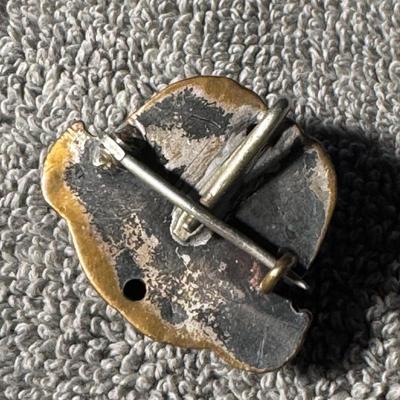
vintage or antique solid brass bulldog figurine head brooch Here's more information about this type of item: Material and Appearance: It is made of solid brass, often exhibiting a aged patina, giving it an antique look. The figurine depicts a bulldog's head in high relief, capturing its characteristic features like wrinkles and jowls. 893 / 1369 -
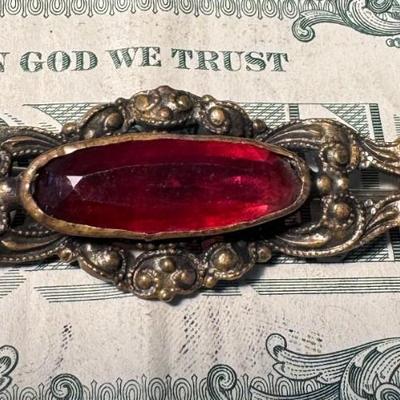
vintage or antique brooch featuring a prominent red gemstone, likely a large red glass or rhinestone, set within an ornate gold-tone or brass-colored metal frame. Here's more information about this type of piece: Style: The intricate scrollwork and decorative elements, along with the large central stone, suggest a Victorian or Edwardian era design, possibly a "Victorian Revival" piece, which emulates styles from earlier periods. Form: It appears to be a bar pin or brooch, characterized by its elongated, horizontal shape and pin clasp on the back, commonly used to secure clothing or adorn lapels. Materials: The piece likely consists of a base metal (such as pot metal or brass) with a gold-tone finish, adorned with a large central red stone and smaller accent stones, which could be glass, rhinestone, or possibly a semi-precious gem like garnet, though the latter would need verification by a jeweler. 894 / 1369 -
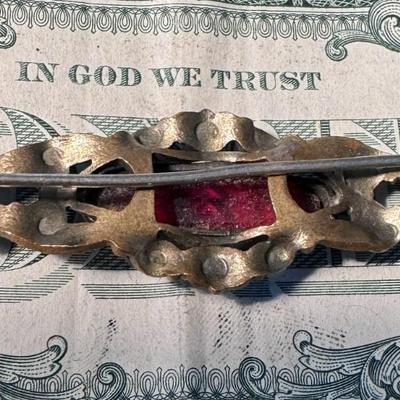
vintage or antique brooch featuring a prominent red gemstone, likely a large red glass or rhinestone, set within an ornate gold-tone or brass-colored metal frame. Here's more information about this type of piece: Style: The intricate scrollwork and decorative elements, along with the large central stone, suggest a Victorian or Edwardian era design, possibly a "Victorian Revival" piece, which emulates styles from earlier periods. Form: It appears to be a bar pin or brooch, characterized by its elongated, horizontal shape and pin clasp on the back, commonly used to secure clothing or adorn lapels. Materials: The piece likely consists of a base metal (such as pot metal or brass) with a gold-tone finish, adorned with a large central red stone and smaller accent stones, which could be glass, rhinestone, or possibly a semi-precious gem like garnet, though the latter would need verification by a jeweler. 895 / 1369 -
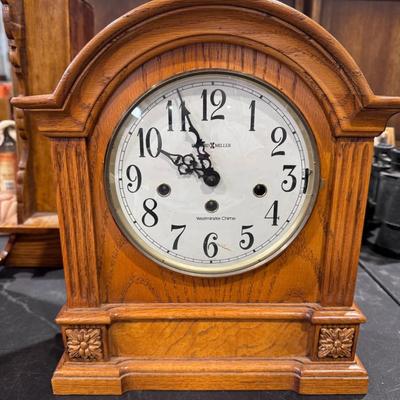
Howard Miller Westminster Chime Mantel Clock. Here's some information about this type of clock: Westminster Chime: These clocks are known for playing the classic Westminster chimes, a melodic sequence commonly associated with Big Ben in London. The chimes typically play a partial melody every 15 minutes and the full Westminster melody on the hour, followed by a strike to count the hour. Movement: Howard Miller Westminster Chime Mantel Clocks can feature either key-wound mechanical movements or battery-operated quartz movements. Key-wound versions often have a dual-ratchet winding arbor for safe winding, while quartz versions might offer features like automatic nighttime chime shut-off. Design & Materials: These clocks typically have a wooden case, often in finishes like Golden Oak or Windsor Cherry, and can include decorative elements like fluted columns or carved overlays. The dial is usually off-white with black Arabic or Roman numerals, and protected by a glass crystal, sometimes convex. 896 / 1369 -
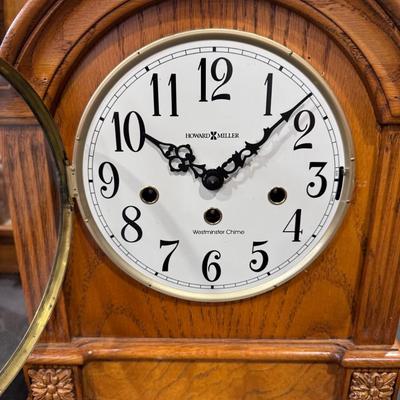
Howard Miller Westminster Chime Mantel Clock. Here's some information about this type of clock: Westminster Chime: These clocks are known for playing the classic Westminster chimes, a melodic sequence commonly associated with Big Ben in London. The chimes typically play a partial melody every 15 minutes and the full Westminster melody on the hour, followed by a strike to count the hour. Movement: Howard Miller Westminster Chime Mantel Clocks can feature either key-wound mechanical movements or battery-operated quartz movements. Key-wound versions often have a dual-ratchet winding arbor for safe winding, while quartz versions might offer features like automatic nighttime chime shut-off. Design & Materials: These clocks typically have a wooden case, often in finishes like Golden Oak or Windsor Cherry, and can include decorative elements like fluted columns or carved overlays. The dial is usually off-white with black Arabic or Roman numerals, and protected by a glass crystal, sometimes convex. 897 / 1369 -
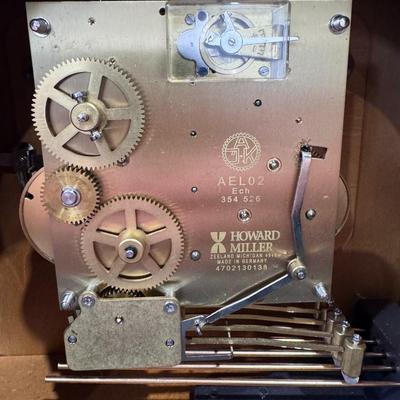
Howard Miller Westminster Chime Mantel Clock. Here's some information about this type of clock: Westminster Chime: These clocks are known for playing the classic Westminster chimes, a melodic sequence commonly associated with Big Ben in London. The chimes typically play a partial melody every 15 minutes and the full Westminster melody on the hour, followed by a strike to count the hour. Movement: Howard Miller Westminster Chime Mantel Clocks can feature either key-wound mechanical movements or battery-operated quartz movements. Key-wound versions often have a dual-ratchet winding arbor for safe winding, while quartz versions might offer features like automatic nighttime chime shut-off. Design & Materials: These clocks typically have a wooden case, often in finishes like Golden Oak or Windsor Cherry, and can include decorative elements like fluted columns or carved overlays. The dial is usually off-white with black Arabic or Roman numerals, and protected by a glass crystal, sometimes convex. 898 / 1369 -
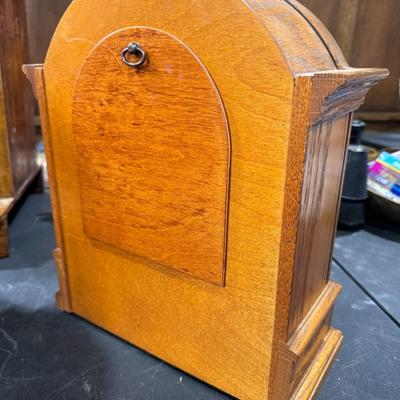
Howard Miller Westminster Chime Mantel Clock. Here's some information about this type of clock: Westminster Chime: These clocks are known for playing the classic Westminster chimes, a melodic sequence commonly associated with Big Ben in London. The chimes typically play a partial melody every 15 minutes and the full Westminster melody on the hour, followed by a strike to count the hour. Movement: Howard Miller Westminster Chime Mantel Clocks can feature either key-wound mechanical movements or battery-operated quartz movements. Key-wound versions often have a dual-ratchet winding arbor for safe winding, while quartz versions might offer features like automatic nighttime chime shut-off. Design & Materials: These clocks typically have a wooden case, often in finishes like Golden Oak or Windsor Cherry, and can include decorative elements like fluted columns or carved overlays. The dial is usually off-white with black Arabic or Roman numerals, and protected by a glass crystal, sometimes convex. 899 / 1369 -
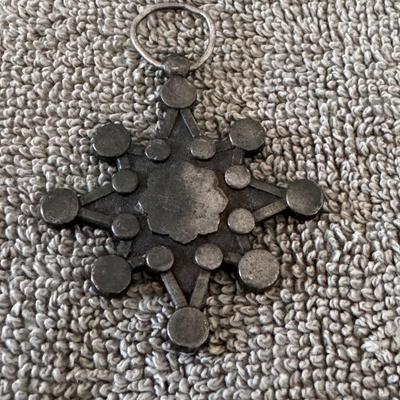
Japanese Star Medal Pendant, made of sterling silver. Here's a breakdown of the item: Description: It's a star-shaped pendant with a loop for hanging, featuring engraved Japanese characters on the reverse side. Similar items are described as originating from the 1930s or related to World War II era Japanese military awards, such as the Order of the Sacred Treasure. Material: Often found in sterling silver, as suggested by product titles and descriptions like "Japanese Star Medal Pendant Sterling Silver". Possible Origin/Purpose: While the specific meaning of the characters isn't detailed, the form and association with "medals" suggest it could be a commemorative piece or a component of a larger medal or award, possibly from a military context or a ceremonial honor. 900 / 1369
Photos 801 - 900 of 1369
Per page:
